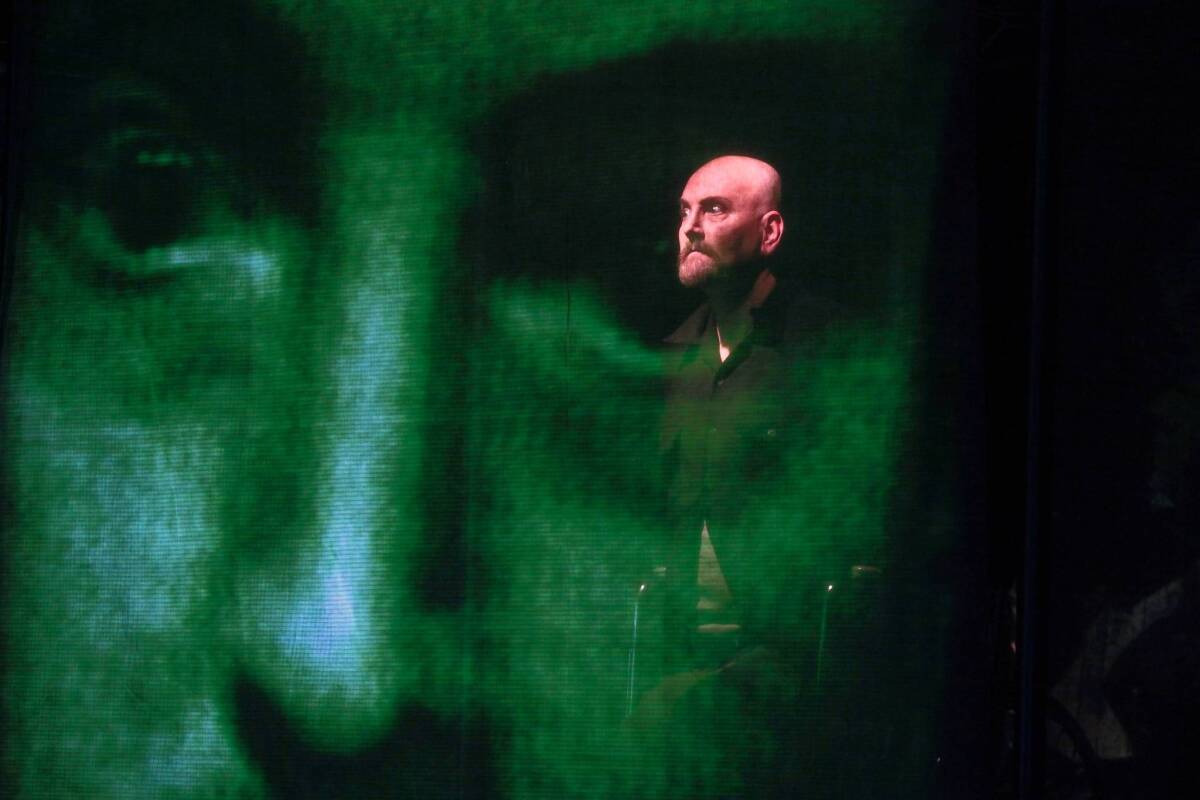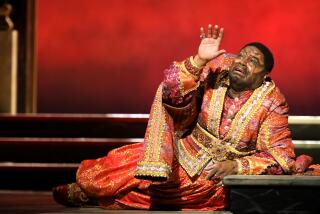Review: ‘Van Gogh’ and ‘Tell-Tale Heart’ have a crazy idea

Opera was born to be mad.
The first great opera concerned the demented Roman emperor Nero. In the nearly three centuries since Monteverdi’s “The Coronation of Poppea,” mad scene has succeeded mad scene on the lyric stage. They still do, as Long Beach Opera demonstrated Saturday night at Bixby Knolls Expo Art Center with a seemingly crazy double bill of two recent American operas — Michael Gordon’s “Van Gogh” and Stewart Copeland’s “Tell-Tale Heart.”
Each opera is, in essence, an excitable — and exciting — extended mad scene. Based on Vincent Van Gogh’s letters, the first follows the suicidal Dutch painter from early expressions of his innate love for the church to his incarceration in a mental ward. The second, a setting of the macabre Edgar Allan Poe tale, enters into the mind of a killer who justifies his sanity by describing his rational approach to premeditated murder, all the while unnervingly falling apart in the telling.
PHOTOS: Arts and culture in pictures by The Times
What made this double bill seem like a crazy project was not subject matter. Nor was it the choice of “Van Gogh,” which is by one of the composers who founded the Bang on a Can collective. Gordon’s opera was released on CD six years ago. One could know to expect a strong work.
But one might not have similar expectations for “Tell-Tale Heart,” written by the former drummer of the rock band the Police who went on to become known for television and film scores (“Wall Street” and “Desperate Housewives” among them). Copeland has also become a composer of operas, although that started badly with “Holy Blood and Crescent Moon,” an absurd and hokey epic about the Crusades commissioned by the Cleveland Opera and given its premiere in 1989. It proved a big-budget fiasco by a composer who clearly did not yet know what he was doing.
I am, however, happy to report that an old rocker can learn new tricks. He also perhaps learned to accept help from the right friends, although in a preconcert conversation with Andreas Mitisek — LBO’s artistic and general director and the evening’s designer and stage director — Copeland indicated that this kind of colorfully updated production is not what he envisioned.
First, the more substantial “Van Gogh,” which is written for three singers and a small ensemble of string quartet, piano, electric guitar, clarinet and lots of percussion. The instrumentalists here as well as for “Tell-Tale Heart” are members of the What’s Next Ensemble, a group of young L.A. musicians who played with panache and were vividly conducted by Benjamin Makino.
“Van Gogh” begins bluntly — rhythmically pounding, harmonically grating and vocally aggressive. But Gordon has a Van Gogh-like capacity for permeating the ordinary with such intense color that everything we take for granted becomes transformed. The opera goes where you don’t expect it, especially in the intimate central section where the lonely Van Gogh expresses his need for a woman.
FULL COVERAGE: 2013 Spring arts preview
Mitisek’s concept was to view both operas as interior dramas by self-destructive men. For Van Gogh, he assembled three compelling singers in soprano Ashley Knight, tenor John Matthew Myers and bass Jason Switzer, but then added an actor, Mark Bringleson, as Van Gogh, writhing in bed.
Mitisek’s set consists of two two-story structures and a steel staircase. One served as a room for a sex scene. Screens could be lowered in front of each quadrant and were used for projecting the artist’s brush strokes. But video designer Adam Flemming’s best stroke was at the end, when Van Gogh became lost among his own yellow flowers.
For Copeland’s half-hour “Tell-Tale Heart” (half the length of “Van Gogh”), Mitisek littered the stage with litter, homeless people, hookers and (get it?) the police (including a fat one munching on doughnuts). The production turns Copeland’s literal retelling of the short story into a flashy, grisly, sexy saga of a serial-killing Poe in a wheelchair. There was plenty to keep your mind off the music, which no doubt is what most took Copeland aback.
But there was also just enough lively trashy stage business to help Copeland’s score come to life. The piece is percussion heavy. The subtle imaginary beating of a victim’s heartbeat, which causes the killer to crack, becomes more like the sound of a construction site, but that can make you crazy too. The strings whine effectively.
Copeland reduces Poe’s text into refrains and adds commonplace rhymes, some of which are declaimed or sung in an effectively punchy pop style. That works far better than the pseudo-arioso attempts in “Holy Blood.”
Baritone Robin Buck was a pathologically creepy Poe. Knight and mezzo-soprano Danielle Bond were two young, drugged-up women in hot pants eager to turn everyone on. The police were Myers and Switzer. Bringelson, as the killer’s victim, spent most of his time catatonically pointing a TV remote, until his number was up. The ending goes beyond Poe, but I won’t give that away.
‘Tell-Tale Heart’ and ‘Van Gogh’
Where: Long Beach Opera, Expo Arts Center, 4321 Atlantic Ave., Long Beach
When: 2 and 8 p.m. Saturday, 7 p.m. Sunday
Tickets: $29 to $160
Information: (562) 432-5934 or https://www.longbeachopera.org
More to Read
The biggest entertainment stories
Get our big stories about Hollywood, film, television, music, arts, culture and more right in your inbox as soon as they publish.
You may occasionally receive promotional content from the Los Angeles Times.







